More about Girl with Cherries

Sr. Contributor
Today’s audiences can learn a lot from Eva Gonzalès, a relatively unknown female Impressionist.
Gonzalès’s mantra may as well have been: "Make friends in high places, work hard, and do what you love." For Gonzalès, her most important friendship, with none other than Édouard Manet, grew from her charm and talent. The two first met when Gonzalès posed for one of his paintings, but their relationship quickly transformed as Manet realized Gonzalès’s innate talent and drive. The only private student that Manet ever took on, Gonzalès obviously alludes to her mentor and teacher with Girl with Cherries.
At first glance, this work seems to recall the dark backgrounds of Rembrandt’s serious, half-length portraits, but Rembrandt never played as fast and loose as the brushwork that Gonzalès employed here. Although inspired by academic work and committed to the Salon, Gonzalès based her practice mostly in the philosophies of Impressionism. Upon closer inspection, Manet’s influence becomes evident. Gonzalès was inspired by Manet’s Spanish-style works, which were in turn inspired by Francisco Goya and Diego Velázquez. After a short visit to Madrid in 1865, Manet declared Velázquez to be “the greatest painter there ever was.”
Luckily Gonzalès was a quick study, and she began to experience her first real successes when she emulated this realistic style. Like Berthe Morisotand many of the other female Impressionists of the era, Gonzalès gravitated toward female subject matter, as this was more socially acceptable for those who dared to venture into the male-dominated world of professional painting. This portrait of an eighteenth-century servant girl (identified by her striped gown and rolled up sleeve) explores female domesticity in ways that would have felt familiar to contemporary viewers, but Gonzalès knowingly omits the bright colors and interior scenes usually attributed to female Impressionists.
Before Girl with Cherries hung on the walls of the Art Institute of Chicago, Annie Swan Coburn and her husband Lewis Larned Coburn owned the painting. Lewis was a wealthy patent lawyer who also founded the Union League Club. A social club for the rich white men of Chicago, the Union League Club has an extensive art collection that Coburn helped to build. After Lewis died, his wife Annie displayed her art collection at her hotel room in the Blackstone Hotel, where she took up residence in 1910 and lived until her death in 1932. Annie buried the suite in paintings that hung on walls, leaned against one another, and were stacked in corners. She left more than seventy works to The Art Institute of Chicago, including a formative set of paintings by Pierre-Auguste Renoir that put the Art Institute of Chicago on the map as a destination for lovers of Impressionism.
Sources
- Kiama Art Gallery. “Impressionism - Eva Gonzales.” 23 July 2015. https://kiamaartgallery.wordpress.com/2015/07/23/impressionism-eva-gonz…. Accessed 2 November 2020.
- Musee d’Orsay. “Manet...Velazquez...The French Taste for Spanish Painting.” Exhibitions. 2002. https://www.musee-orsay.fr/en/events/exhibitions/archives/exhibitions-a…
- The Art Institute of Chicago. “Case 8: Annie Swan Colburn.” Women of the Art Institute. Library Exhibitions. 2013. https://archive.artic.edu/ryerson/making-history/8. Accessed 2 November 2020.
- The Art Institute of Chicago. “Girl with Cherries.” The Collection. https://www.artic.edu/artworks/36678/girl-with-cherries. Accessed 2 November 2020.
- The Union League Club of Chicago. “Our Story.” https://www.ulcc.org/web/pages/about-us. Accessed 2 November 2020.
- Witte, Rachel. “Eva Gonzalès: Impressionist in the Shadows.” Daily Art Magazine. 30 July 2020. https://www.dailyartmagazine.com/eva-gonzales-impressionist/. Accessed 2 November 2020.











